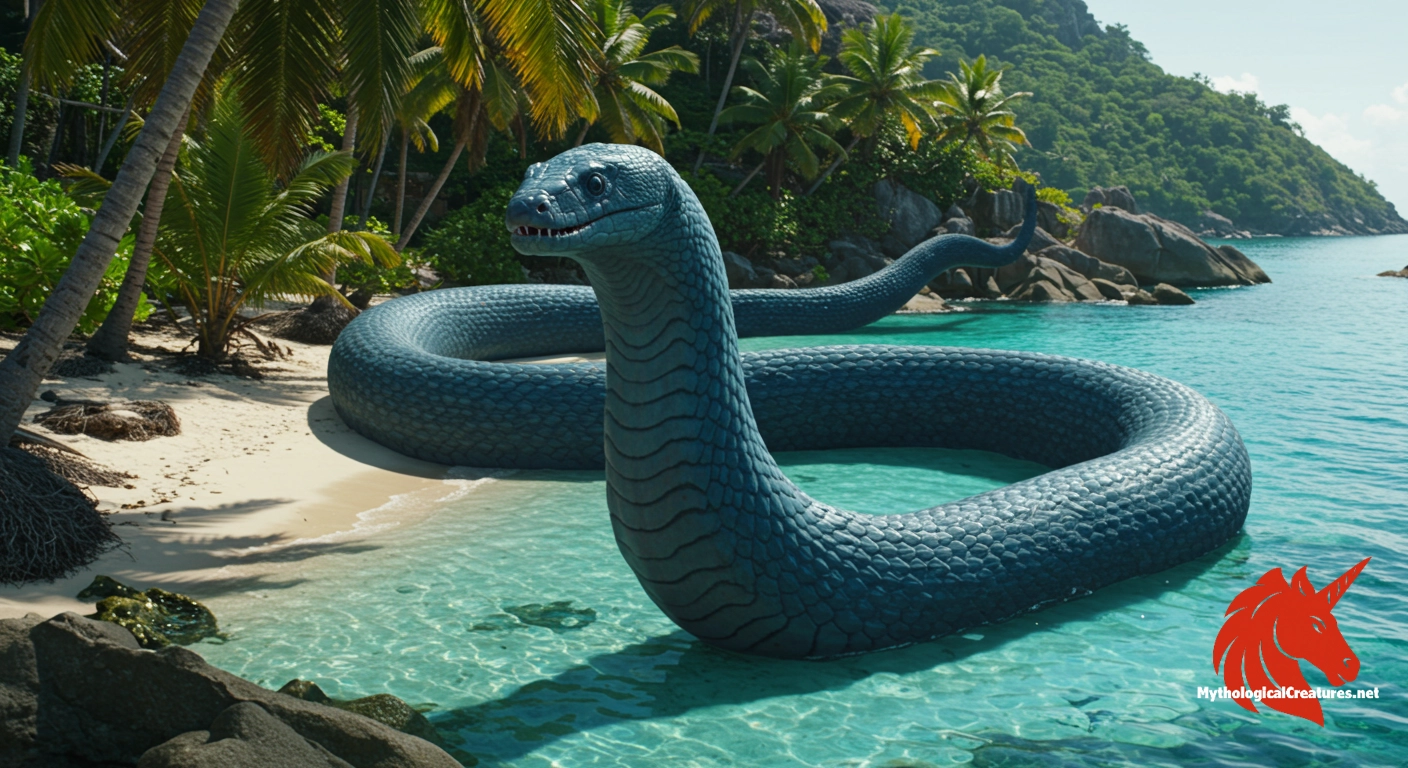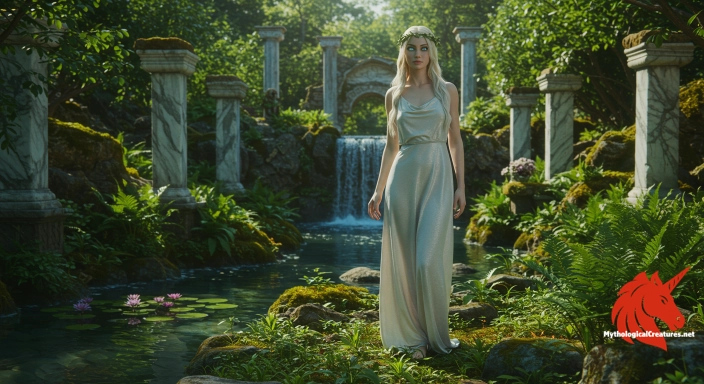Agunua: Agunua, also known as Hatuibwari, is the cosmic serpent god and chief deity of the Solomon Islands' San Cristobal people.

Agunua
Agunua - Agunua is revered as the supreme deity whose omnipresence reinforces the cosmic order and the sacred balance between nature and divinity.
Origins & First Encounters
Agunua, also known by the alternate name Hatuibwari, stands as the cosmic serpent god and the supreme deity in the lore of the San Cristobal Island people of the Solomon Islands. His origins are deeply woven into ancient oral traditions, where the interplay of the land and the endless sea gives him his mighty presence. The tradition of dedicating the first coconut from each tree to him symbolises not only a sacred ritual but also a profound connection with the natural world. His emergence in mythic lore reflects early attempts by his people to understand and venerate powerful natural forces. As the chief god, Agunua embodies a duality of creative energy and protective authority that resonates through every aspect of life on Makira. The deity’s association with both the ocean and the coconut harvest underscores his integrative role in uniting the realms of nature and civilisation. Early attestations of his myth were maintained through generations of storytellers, ensuring that his divine influence was passed on as a living heritage. His character, lavishly portrayed in various indigenous narratives, compels both awe and reverence, blending the mystique of the heavens with the relentless power of the sea. Even today, Agunua remains a central figure, symbolising the deep-rooted spiritual and cultural connection the islanders share with their environment.
Source Texts & Tale Variants
The story of Agunua has been largely preserved through an intricate network of oral traditions handed down by community elders and local shamans. His dual nomenclature, Agunua and Hatuibwari, reflects layers of linguistic and cultural evolution that have enriched his narrative over time. Numerous folklore accounts recount his role as the creator of lesser gods, with each story variant contributing unique aspects to an overall portrait of cosmic grandeur. Early written records, compiled during periods of colonial contact and missionary work, have captured fragments of his myth, though these documents often represent just one perspective among many. In some retellings, Agunua is portrayed as a benevolent force nurturing both land and sea, while other versions highlight his formidable, awe-inducing power. Storytellers often introduce local phenomena such as unusual tides or seasonal changes as expressions of his divine intervention. The depth of his myth is further illustrated in ritual performances and ceremonial recitations, which adapt the ancient narrative to contemporary contexts. Each version of the tale emphasizes different elements of his cosmic authority, ensuring that his legacy remains rich and multi-dimensional. These diverse accounts not only provide insight into his character but also highlight the dynamic interplay between tradition and cultural adaptation in the Solomon Islands.
Form & Powers
Agunua is envisioned as a majestic and awe-inspiring serpent whose form seamlessly bridges the terrestrial with the celestial. His elongated, sinuous body is said to be adorned with scales that shimmer with the deep blues of the ocean and the silvery glimmer of starlight, evoking the celestial canvas of night. Intricate patterns on his scales are often interpreted as ancient symbols or cosmic constellations, each telling its own story of creation. His eyes, luminous and penetrating, are believed to hold an ageless wisdom and the secrets of both the land and sea. Artistic depictions sometimes render him with faint, ethereal fin-like extensions, which signify his intimate dominion over the waters. In certain traditions, Agunua is even imagined with a twin tail or bifurcated form, symbolising his dual role as both creator and sustainer of life. His formidable appearance is balanced by an aura of grace and benevolence, making him a deity to be both revered and respected. The visual imagery associated with him is as fluid as the ocean waves yet as enduring as the ancient rocks of his island home. Across various renditions, his physical attributes contribute not just to his mystique but also to a deeper reverence for the forces of nature that he embodies.
Regional Faces
While the core essence of Agunua remains steadfast throughout the Solomon Islands, his portrayal exhibits distinct nuances across different regions and communities. On San Cristobal Island, his connection to the first coconut of every tree accentuates the importance of natural rebirth and sustenance, forging a ritualistic bond with agriculture. In coastal areas, where the relentless interplay of tides governs daily life, his dominion over the sea is more pronounced, and local myths often elaborate on his role as a guardian of maritime ventures. Variations of his tale adapt regional symbols and artistic motifs, resulting in diverse visual representations that reflect the indigenous aesthetics of each community. In some villages, the deity is more intimately associated with the environmental rhythms of the island, with festivals and ceremonies custom-tailored to the cycles of the ocean and the harvest season. Local interpretations may also vary in the emphasis they place on his dual identity as a nurturing force and a formidable cosmic presence. The alternate name Hatuibwari is sometimes preferred in regions where linguistic traditions emphasise ancestral lineage and celestial connectivity. Such regional variations highlight the adaptive nature of Agunua’s myth, ensuring his legend remains both dynamic and relevant. Regardless of local adaptations, a common thread of reverence and respect for the cosmic serpent is evident across the islands, uniting disparate communities through a shared cultural heritage.
Cultural Parallels
Agunua’s myth finds fascinating parallels in a number of other global traditions, where the cosmic serpent symbolizes primordial creation and infinite cycles of renewal. His representation shares thematic similarities with the Rainbow Serpent of Australian Aboriginal lore, both of which serve as custodians of natural law and environmental balance. Much like the mythic serpents and dragons found in Norse and East Asian traditions, Agunua embodies a synthesis of destructive power and regenerative benevolence. The imagery of a serpent traversing both heavens and seas is a recurrent motif that underscores the universal quest to explain the mysteries of nature. His dual role as a creator and protector echoes the symbolic functions of deities like the Hindu serpent god or the Mesoamerican feathered serpent, where cosmic order is maintained through divine intervention. The sacred act of dedicating the first coconut to him resonates with other cultures’ practices of honouring a deity with the first or best yield of nature, further cementing his role in agricultural and maritime rites. Such cultural parallels invite a broader discussion on how ancient societies perceived the unity of nature and the cosmos. By comparing Agunua with other transformational figures, it becomes evident that his story is part of a larger symbolic framework shared by many indigenous peoples. In this wider comparative context, the cosmic serpent emerges not just as a local myth but as a potent emblem of cross-cultural spiritual insight and ecological wisdom.
Legacy & Modern Evolution
Over the centuries, the myth of Agunua has evolved in response to shifting cultural and environmental landscapes, yet his timeless symbolism endures. Early traditions, preserved within intimate communal rituals, have gradually been reinterpreted by modern scholars and local artists who continue to celebrate his divine attributes. Contemporary portrayals often blend ancient iconography with modern aesthetic sensibilities, resulting in vibrant depictions that speak both to tradition and the present day. His representation as the guardian of the first coconut has become a metaphor for renewal and the enduring bond between nature and humanity, inspiring new generations to reconnect with their ancestral heritage. Festivals and cultural ceremonies continue to showcase his legend, reinforcing community identity and environmental stewardship in a modernised context. Agunua’s story has also found its way into academic discourse and popular culture, where his image serves as a reminder of the rich mythological tapestry that defines the Solomon Islands. In re-imagining his myth, modern interpretations often emphasise themes of ecological balance and sustainability, reflecting a global awareness of nature’s fragility. His enduring legacy not only honours traditional beliefs but also provides a bridge between ancient wisdom and contemporary environmental and cultural challenges. The evolution of Agunua’s myth is a testament to the resilient spirit of indigenous cultures, adapting over time while keeping a sacred connection with the natural world intact.
Interesting Fact
Agunua uniquely blends serpentine imagery with environmental symbolism, as evidenced by the sacred status of the first coconut and his dual role as both a cosmic and sea deity.
Quick Creature Info
Origin:
Associations:
Our Mythic Legendary Rating:

Also Sometimes Known As:
Habitat:
Supernatural Powers:
Physical Attributes:
Abilities:
Behavior:
Lore:
Related Creatures, Tales or Lore
- QQuetzalcoatl
- JJörmungandr
- RRainbow Serpent
References
Discover Another Mythical Legend You May Not Have Heard Of?
Uncover the mysteries of ancient folklore and expand your knowledge of legendary beings from cultures around the world.
Dare to Meet the Polyxo....
Curated by the Mythological Creatures Team (rev. May 2025)
